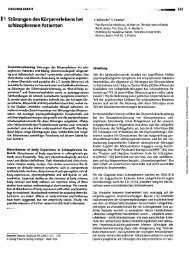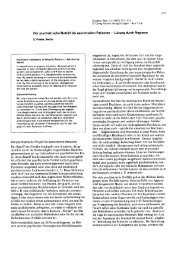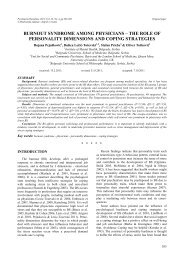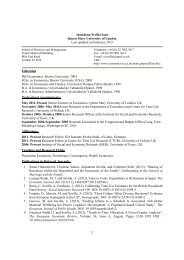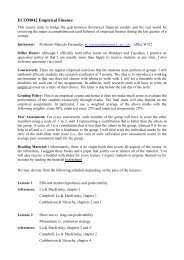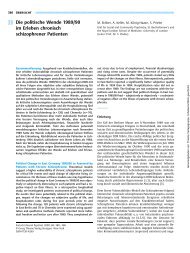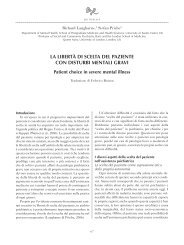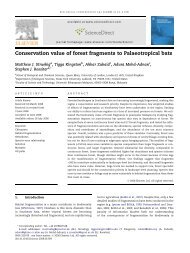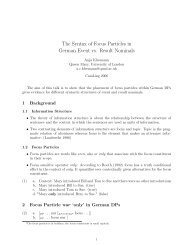Proofs - Personal Webspace for QMUL - Queen Mary, University of ...
Proofs - Personal Webspace for QMUL - Queen Mary, University of ...
Proofs - Personal Webspace for QMUL - Queen Mary, University of ...
Create successful ePaper yourself
Turn your PDF publications into a flip-book with our unique Google optimized e-Paper software.
society, history (slavery and colonization) and gender relations<br />
on self- concepts. We compare such cultural concepts with<br />
respect to three topics: fi rst, the question <strong>of</strong> dissociation and<br />
spirit possession, secondly the question <strong>of</strong> the embodied self<br />
including a discussion <strong>of</strong> current neurobiological explanations<br />
<strong>of</strong> self- referential processing, and fi nally with respect to social<br />
per<strong>for</strong>mances <strong>of</strong> self- related narratives. We end by suggesting<br />
that core aspects <strong>of</strong> self- related experiences such as prerefl ective<br />
self awareness appear to be a universal human trait, while diverse<br />
social and cultural norms interact with and modify narration and<br />
per<strong>for</strong>mance <strong>of</strong> self concepts and constructions. Such a cultural<br />
variety has to be considered when diagnosing alterations <strong>of</strong><br />
self- concepts and “ego disorders” in various cultural and social<br />
contexts.<br />
2. Classical concepts <strong>of</strong> the self and the problem<br />
<strong>of</strong> circularity: the “infi nite regress”<br />
<strong>of</strong> self- consciousness<br />
While neither history nor culture originated in classical<br />
Greece, concepts which have been articulated in this culture<br />
coined central aspects <strong>of</strong> the European tradition. Some <strong>of</strong> the<br />
oldest traditions appear not to distinguish categorically between<br />
mind and matter, and pre- Socratic philosophies tried to identify<br />
fundamental principles <strong>of</strong> nature. Such fundamental principles<br />
were alternatively identifi ed in the element <strong>of</strong> water (Thalis)<br />
or the air or individual breath (Anaximenis). In this context<br />
Pythagoras was one <strong>of</strong> the fi rst to suggest the idea <strong>of</strong> an eternal<br />
soul, which appears to be infl uenced by East- Asian concepts<br />
<strong>of</strong> reincarnation or soul migration and by the ecstatic cult <strong>of</strong><br />
Dionysos [43]. Plato also articulated a concept <strong>of</strong> an immortal<br />
soul and distinguished between the deceitful world <strong>of</strong> the senses<br />
and the immortal <strong>for</strong>ms or “ideas”. This concept <strong>of</strong> ideas was <strong>for</strong><br />
example developed when asking what it means to be “beautiful”<br />
and was aimed at the defi nition <strong>of</strong> “the beautiful” itself, and it<br />
was suggested that this idea is an object <strong>of</strong> pure thought and not<br />
<strong>of</strong> the senses [39]. The relation <strong>of</strong> any concrete object to such an<br />
idea was conceptualised as a <strong>for</strong>m <strong>of</strong> participation.<br />
Aristoteles (1970), on the other hand, did not propose that<br />
ideas have an existence which is independent <strong>of</strong> concrete objects.<br />
His key concept is easier to grasp when we acknowledge that<br />
the Greek word “eidos” can be translated into Latin as “<strong>for</strong>ma” or<br />
“species”, suggesting that ideas represent the <strong>for</strong>m <strong>of</strong> an object.<br />
For example, Aristoteles suggested that the <strong>for</strong>m <strong>of</strong> a human<br />
being would only manifest in matter, namely in the fl esh, bones<br />
and other parts <strong>of</strong> a human being; nevertheless, bones and fl esh<br />
would not be a part <strong>of</strong> the <strong>for</strong>m or concept <strong>of</strong> a human being but<br />
instead represent the matter, in which the <strong>for</strong>m manifests itself.<br />
He went on to suggest that the soul would be the primary <strong>for</strong>m<br />
<strong>of</strong> a living being, and this concept thus acquired a functional<br />
meaning [2]. The soul is there<strong>for</strong>e not perceived as an immortal<br />
idea, which somehow resides in a material body, but rather<br />
Aristoteles suggested that the soul is the <strong>for</strong>m or function <strong>of</strong> a<br />
defi nite body, like “being an axe” represents the functional <strong>for</strong>m<br />
<strong>of</strong> this instrument [3]. As <strong>for</strong>m or function <strong>of</strong> a human being,<br />
the soul has three different aspects: the potential <strong>of</strong> nutrition,<br />
which is shared with all living beings such as plants, the potential<br />
<strong>of</strong> sense perception and desire <strong>for</strong> positive experiences, which<br />
is shared with animals, and intellectual insight, the highest<br />
A. Heinz et al. / European Psychiatry 27 (2012) / supplement n°2 / S32-S43 S33<br />
potential <strong>of</strong> any human being. Aristoteles compared the domination<br />
<strong>of</strong> intellectual insight over desires with the domination,<br />
which politicians exert with respect to the people, and suggested<br />
that such intellectual capacities are lacking in slaves and are<br />
ineffective in women and undeveloped in children [43].<br />
Aristoteles also identifi ed one <strong>of</strong> the problems characterising<br />
several concepts <strong>of</strong> self- consciousness: the question who or<br />
what actually perceives what is represented in the senses. This<br />
problem can be illustrated when we refl ect on some common<br />
concepts <strong>of</strong> sense perception. For example, when we look at a<br />
tree, we are usually aware that the outer object (the “real tree”)<br />
may somehow differ from our percept: we perceive only some<br />
part <strong>of</strong> the outer object or the way in which we perceive it may<br />
depend as much on the constitution <strong>of</strong> our senses as on the out<br />
object itself, e.g. the “real tree” refl ects light waves, which we<br />
perceive as green but which appear indistinguishable from red<br />
in case <strong>of</strong> colour- blindness. Nevertheless, in everyday life, we<br />
usually assume that our senses represent a reliable and useful<br />
percept <strong>of</strong> our environment. Hume (1978) called such perceptions<br />
“impressions”. When we close our eyes, we can maintain a<br />
mental picture <strong>of</strong> what we have just seen – Hume called this an<br />
“idea” and suggested, that, compared to impressions, ideas are<br />
less vivid and clear [27]. However, we would like to suggest that<br />
a decisive difference between an impression and an idea resides<br />
in the malleability <strong>of</strong> the phenomenon: an idea can be actively<br />
modifi ed (<strong>for</strong> example, we can imagine that the tree stands on<br />
its head), while this is not possible with any given perception. So<br />
if “we” can modify “ideas”, which are obviously different from<br />
impressions, one may ask where such ideas are “perceived” and<br />
modifi ed. In everyday life, we may assume that this perception is<br />
located somewhere in the mind or brain; however, this explanation<br />
only doubles the problem: now we have three trees, a real<br />
one (the thing in itself), a perceived one (the impression) and an<br />
imagined tree (the idea). Husserl (1962) would probably object<br />
to our “common sense” reasoning and point to the fact that there<br />
is not “one tree in the mind (brain)” and “the other one outside”<br />
but that instead in both situations we are intentionally focussed<br />
on the tree, in one case on a tree that we assume to be real and<br />
in another case on a tree that we imagine to be an idea [28].<br />
However, this argument may still not help to answer the question<br />
who or what actually perceives the ideas or impressions. Is there<br />
an independent “ego” in the mind or brain, which “perceives”<br />
the impressions or ideas <strong>of</strong> sense objects? Or are these impressions<br />
somehow transparent <strong>for</strong> consciousness? But than what is<br />
consciousness? In Aristoteles words: “Inasmuch as we perceive<br />
that we see and hear, it must either be by sight or by some other<br />
sense that the percipient perceives that he sees. But, it may be<br />
urged, the same sense which perceives sight will also perceive the<br />
colour which is the object <strong>of</strong> sight. So that either there will be two<br />
senses that perceive the same thing or the one sense, sight, will<br />
perceive itself. Further, if the sense concerned with sight were<br />
really a distinct sense, either the series would go on to infi nity<br />
or some one <strong>of</strong> the series <strong>of</strong> senses would perceive itself” [3].<br />
Aristoteles did not try to answer the question who is the<br />
subject <strong>of</strong> perception and instead focuses on the problem how<br />
the sense organ can get in contact with the perceived object.<br />
Nevertheless, the question who perceives ideas in the mind<br />
continues to trouble Western philosophy. If the ideas are impressions<br />
<strong>of</strong> outer objects, is a “self” or “soul” the entity that perceives<br />
<strong>Pro<strong>of</strong>s</strong><br />
07_Heinz.indd S33 14/06/2012 11:29:58




